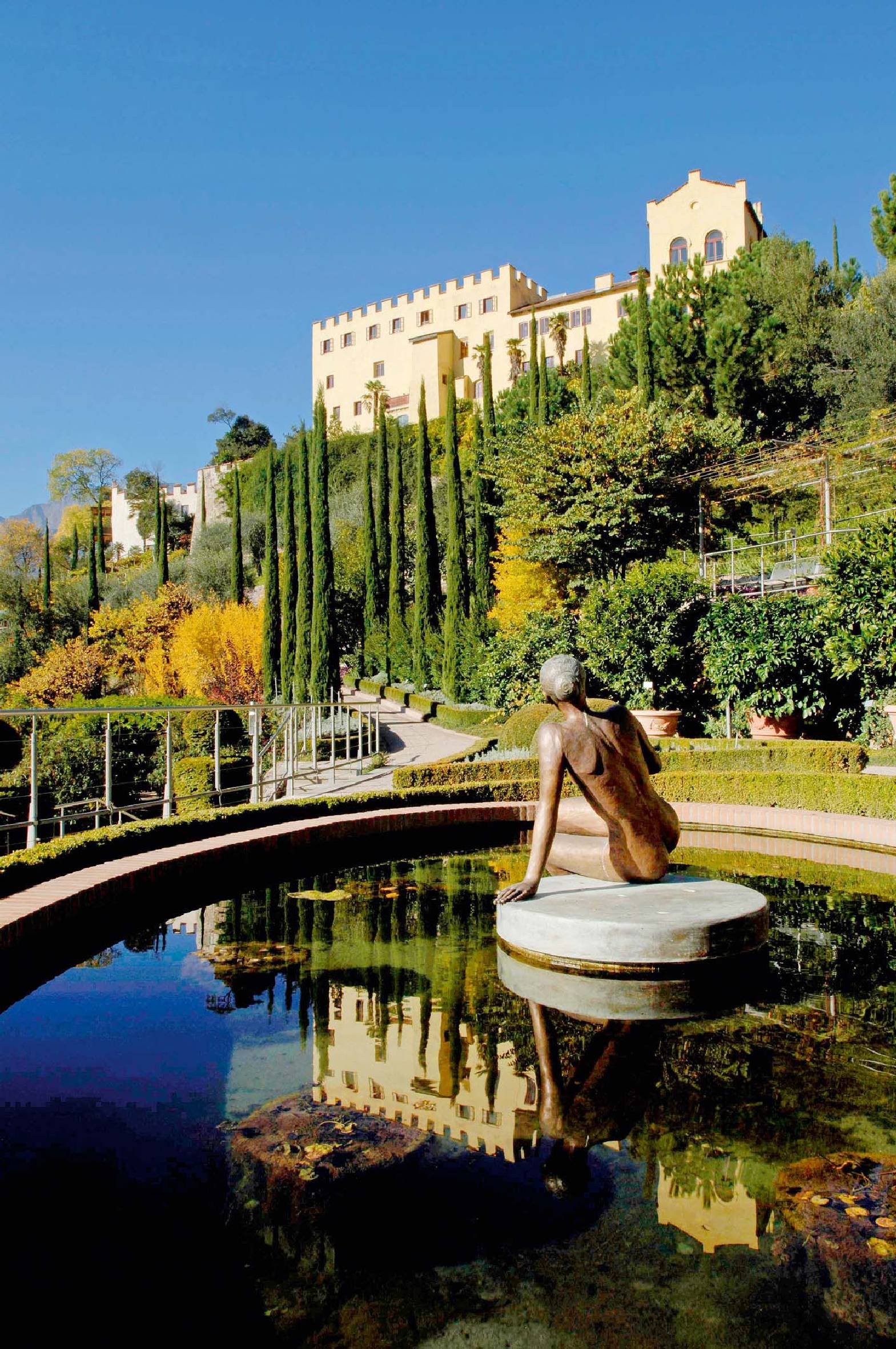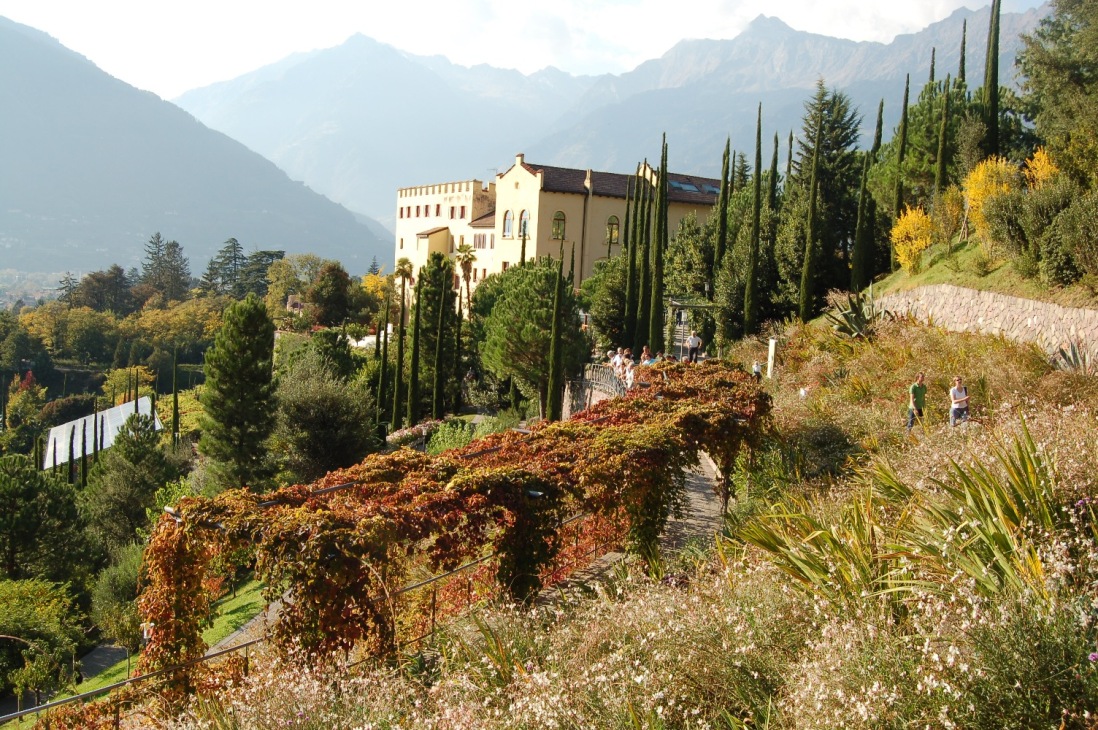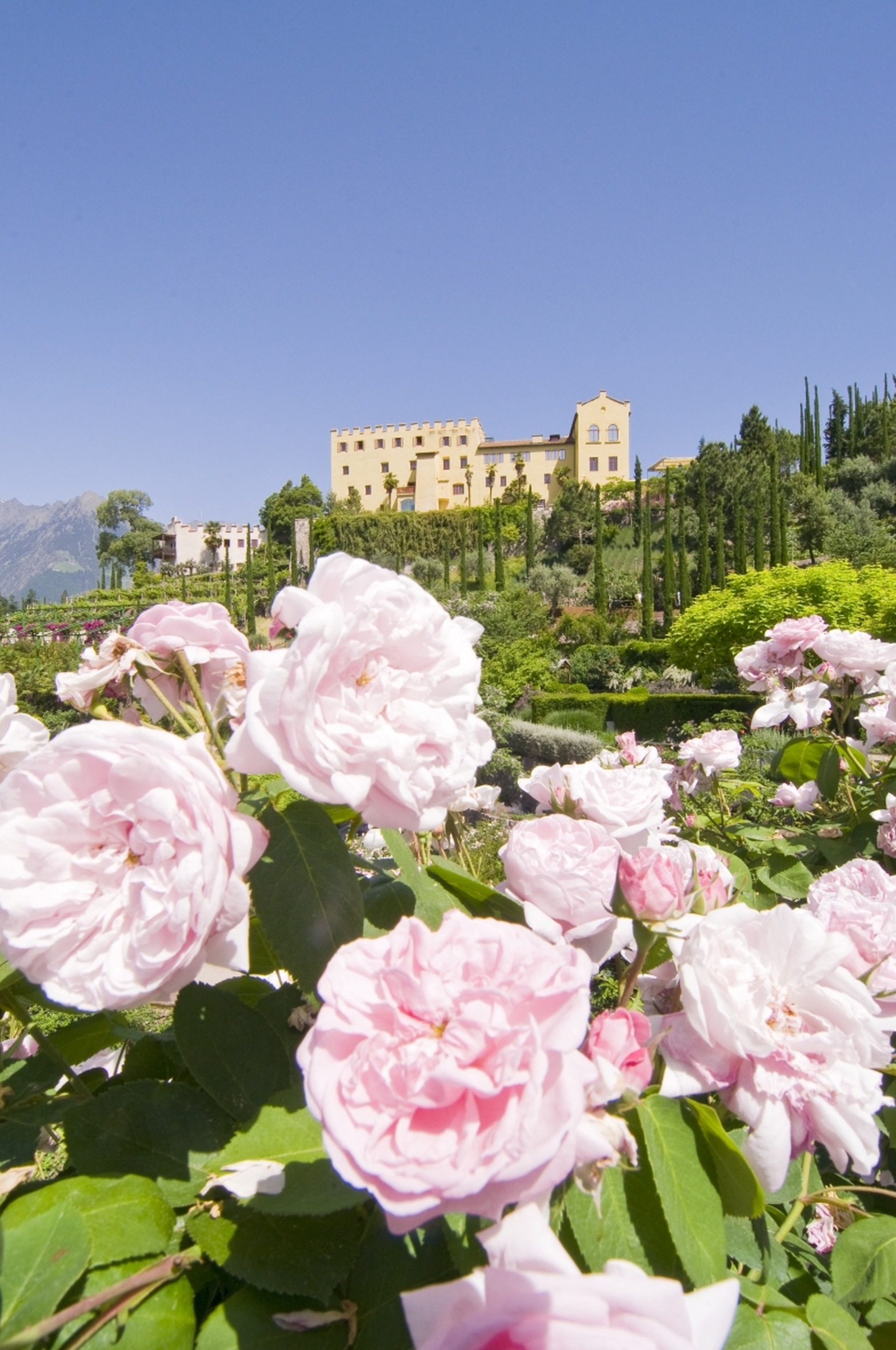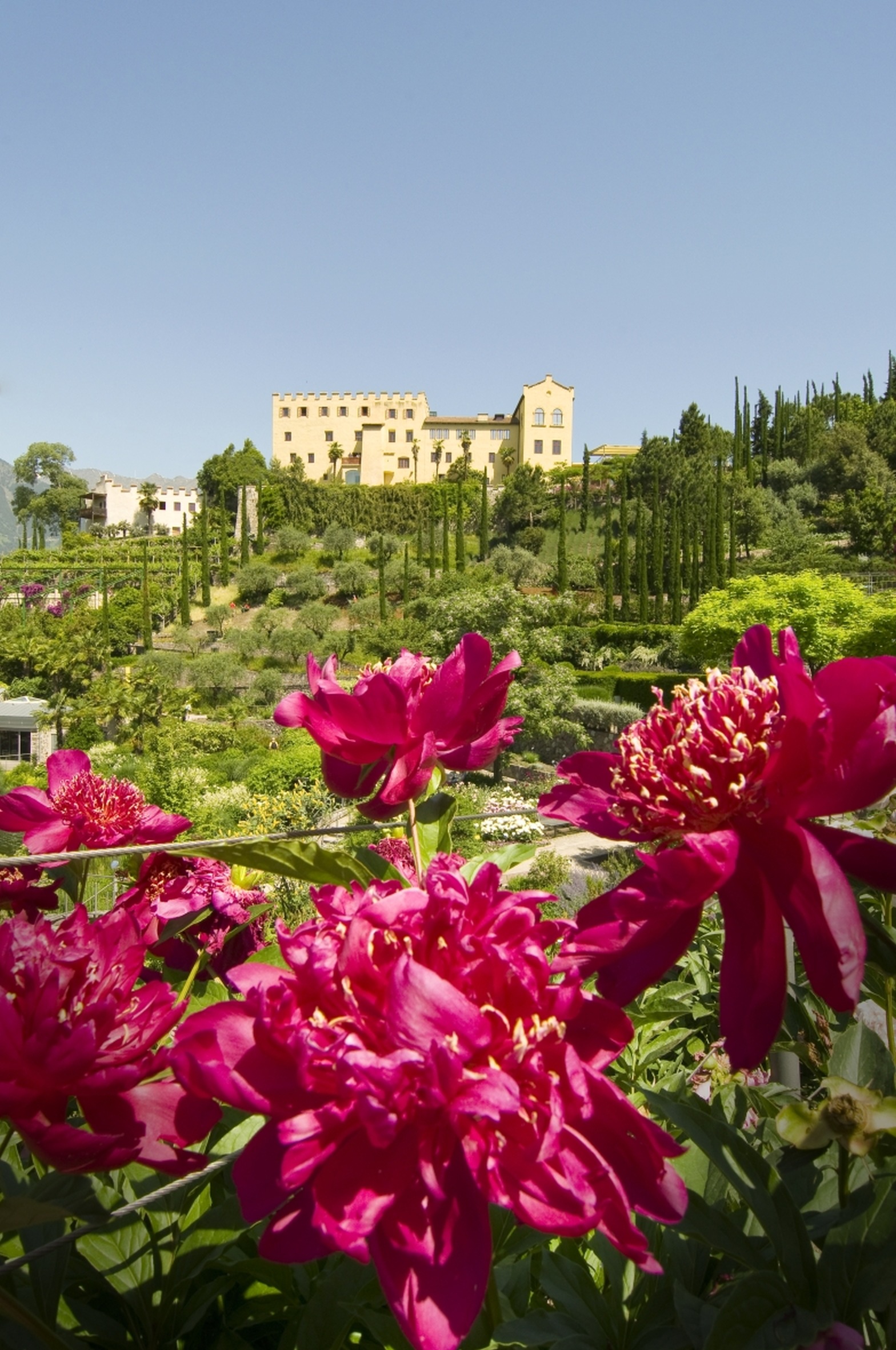
The Gardens of Trauttmansdorff Castle
This post is also available in:
 Italiano (Italian)
Italiano (Italian)
The Gardens of Trauttmansdorff Castle, also known as “Sissi’S Gardens” (honouring the beloved Austrian empress who regularly enjoyed them during her life), are in Merano, on a large sun-kissed amphitheatre, covering a 30-acre sloping surface. Opened in 2001, they host 80 botanical environments, with different landscapes, themed gardens, terraces, streams, plants from all over the world (most of them growing outdoors), artistic pavilions, multisensory stations, and much more. From spring to autumn, there’s always some eye-catching blooming, as well as themed exhibitions for visitors of all ages.
The local municipality started building these gardens in 1994 to pay a homage to Empress Sissi, whose presence greatly contributed to the fortune of this city, and to renew its long tradition of botanical experimentation and research: in fact, Merano has been nicknamed “the garden city” since the mid-XIX century, internationally acknowledged for its great variety of plants, including the Mediterranean and exotic species, which have eventually adjusted to this peculiar northern microclimate. European and Japanese architects and landscape designers participated in the construction of this large and variegated green facility.
IN THE FOOTSTEPS OF SISSI
On the second floor of Trauttmansdorff Castle, visitors can admire the historic rooms inhabited by the Empress Elisabeth of Austria (Sissi). The fresco room, with a richly decorated wooden ceiling and works of art dating back to 1564, is the oldest room in the castle. During her first stay, in 1870/71, the Empress slept right there, while in 1898 she turned that very space into her dressing room.
Since 2008, the Castle has hosted a permanent exhibition dedicated to the illustrious tenants of the building. Original personal objects and a modern audio-guide introduce the mesmerized visitors to the very world and life of that famous Empress.
The garden is thick with items and places related to Sissi, such as the terrace and the throne of the Empress; Baron von Deuster (the owner of Trauttmansdorff Castle from 1897 to 1921) organized a princely party in 1908, in memory of the last visit of the Imperial couple to his residence. For that occasion, he had that very white marble throne (some 10-ft wide) built in the shade of an old chestnut tree – one of Sissi’s favourite places in the garden.
Since 2005, the throne has been relocated on the open terrace, on the southern side of the castle: over there, visitors can enjoy a magnificent view of the botanical garden and, in particular, of the pond with the water lilies.
The “Promenade of Sissi” is also a very evocative part of the gardens, featuring a marble bust of the Empress; she was very keen on physical exercise and loved walking around this property, therefore she had some nice gravel paths built in the oak wood (Quercus pubescens) near the Castle – “I’d like to be able to walk undisturbed from the hustle and bustle of the world”, as she personally stated.
THE GARDENS
The gardens are divided into 4 large, themed areas, which include several different environments and botanical rarities: the “Gardens of the Sun”, the “Woods of the World”, the “Aquatic and terraced gardens”; the “Landscapes of South Tyrol”.
The “Gardens of the Sun”
Built on the southern slope, this area is dedicated to the Trentino and the Mediterranean landscapes. It features evergreen trees and shrubs, including holm oaks (Quercus ilex), cork oaks (Quercus suber), olive trees (in the northernmost grove in Italy), as well as 700-year-old specimens of pines and cypresses. There are also lush fruit plants typical of southern Italy, such as pomegranates, vines, figs and mulberries – not to mention hundreds of sunflowers, oranges, lemons, kumquats, bergamots and spectacular “Buddha’s hand” cedars. The “Gardens of the Sun” also feature succulent plants, large South African specimens of Aloe, North African Agave, and numberless members of the Euphorbiaceae family. In the winter, this very area is closed and protected inside a greenhouse.
The “Woods of the World”
This section of the gardens can be found on the northern side of the castle, offering some pleasant coolness during the summer. Small portions of the North American, South American and East Asian forests were built right there with large specimens of broad-leaved and coniferous trees. Then there’s the the “Valley of the Ferns”, featuring streams and waterfalls flowing around beautiful specimens of Ginkgo biloba, monkey puzzles, dawn redwoods, and a precious Wollemia nobilis: a prehistoric plant thought to be extinct. The Japanese Garden inserted in this very area, feature all its most typical elements such as water, stones and plants closely related to the Asian civilization. There’s also a rice paddy, a tea plantation, some botanical collections which include flowering cherry trees, and over 300 varieties and species of rhododendron.
The ”Clay Walls” section, on the other hand, consists of 1.794 square yards of flower beds arranged in a semi-perpendicular position.
The “Beach of the Palms” then, evokes the romantic atmosphere of tropical destinations, despite the snow-capped peak backdrop. Finally, there’s the greenhouse opened in 2014, which hosts tropical plants and a terrarium with insects and lizards from all over the world.
In this section of the gardens, there is also a small forest with 40 different varieties of bamboo.
The “Aquatic and Terraced Gardens”
Stairways and streams of water connect the different levels of this area, creating the typical look of the European garden architecture: there are boxwoods, geometric flower beds, and labyrinths, which evoke the Italian Renaissance style: the geometric flower beds, in particular, are the quintessence of the traditional English gardens.
Aromatic plants, roses, lilies and jasmine are neatly arranged in the stimulating “Garden of the Senses”, while at the foot of the terraces, there is the romantic “Pond of the Water Lilies”, full of Koi carp, ducks, turtles and many other specimens of aquatic fauna; the pond is surrounded by the luxuriant riparian vegetation dominated by iris, daylilies and marsh plants. In the area dedicated to lotus flowers (Nelumbo nucifera), there is also a thicket of palms with more than 200 specimens mixed with camellias and azaleas.
Then, there are the collections of clematis and peonies, and the “Rose Garden”, hosting 50 wild species and 30 historical varieties.
The Labyrinth, included in this portion of the gardens, was built with yew hedges (Taxus baccata) and features a pomegranate tree in its centre (Punica granatum)
The “Landscapes of South Tyrol”
This area stretches along the course of an artificial stream. It features a downy oak wood (Quercus pubescens) and a riparian forest dominated by alders and willows (that used to cover the marshy plains in the main valleys of Alto Adige). Then, there’s the typical marsh vegetation (cattails and reeds) growing on the lake shores.
This portion of the gardens is also home to a large “Flowered Meadow”, and an extensively cultivated orchard with ancient varieties of apples and pears.
The vineyard, on the other hand, features the “Gewürztraminer”, “Schiava” and “Lagrein” grape varieties, as well as a dozen of very ancient indigenous vines, mostly no longer cultivated.
There is also a precious collection of objects produced in the course of three millennia of South Tyrolean winemaking history. For instance, there’s a gold copy of 7000-year-old grape seeds, donated from the National Museum of Tbilisi, Georgia, and some endemic 2400-year-old grape seeds.
Finally, the vegetable garden is bordered by the typically intertwined palisade, handmade by a farmer from the nearby Val d’Ultimo. Narrow walkways separate the different garden plots planted with vegetables, flowers, aromatic and medicinal plants.
In 2011, a unique installation of its kind was opened right here: it’s the “Underground Kingdom of Plants” and features a multimedia educational path, some 220-yard long, carved into the rock; a most intriguing game of lights and sounds leads to the in-depth observation of the plants which can live underground, having established a most unique relationship with water, earth, nourishment, their very root systems and light.
The animals living at Trauttmansdorff Castle are another major attraction – there are rabbits, peacocks, Hungarian Racka sheep, dwarf goats, Chinese ducks, Japanese carp, and many others.
Art exhibitions, music concerts and other cultural initiatives are regularly organized on the premises throughout the year.
PERIODS OF INTEREST
Spring: visitors can enjoy the blooming tulips, daffodils, Kaiser’s crows, buttercups, Ice poppies, camellias, Japanese cherries, rhododendrons, peonies and other flowering shrubs and fruit trees.
Summer: visitors can enjoy the blooming of flower beds, roses, lavenders, Mediterranean plants, the Flowered Meadow, water lilies and lotus flowers, the expanse of sunflowers, and garden flowers.
Autumn: late herbaceous perennials bloom, (from September onwards) in the “Aquatic and Terraced Gardens”; visitors can also enjoy the blooming of autumn camellias, strawberry trees, pomegranates, figs, olives and grapes. The autumn foliage of the broad-leaved trees in the “Woods of the World” is absolutely magnificent.
BOTANICAL RARITY
A sensational botanical discovery was made in 1994: around 100 specimens of a conifer believed to be extinct were found in an Australian gorge: it was the Wollemia nobilis, widespread all over the world up to 65 million years ago. An international program for the proliferation and breeding of this interesting plant has ensured its survival since 1999.
Since April 2006, the Gardens of Trauttmansdorff Castle have owned a valuable specimen, the first in Italy: it can be admired the “Valley of the Ferns”, together with other “living fossils” such as Ginkgo biloba and Metasequoia glyptostroboides.
To study the plant’s resistance to the cold, an agreement has been made with the Australians: the conifer spends the winter outdoors and, in the event of damage caused by the frost, it will be replaced by the Australian government.
Among 400 rhododendrons in the Gardens, there is a 13-16-ft tall specimens of Rhododendron arboreum from Lake Maggiore.
The “Gardens of the Sun” also host a spectacular 700-year-old olive tree from Sardinia. Its trunk is some 10-ft wide and measures about 3 ft at chest’s height.
Trauttmansdorff Castle has the largest collection of sage in Italy, which includes 154 varieties and species from different continents.
FURTHER INFORMATION
The largest vine in the world can be admired at the foot of the nearby Katzenzungen Castle – the Gardens of Trauttmansdorff Castle were entrusted with its patronage in 2006: it is a “Versoaln” plant belonging to the ancient autochthonous vine variety of Val Venosta. Its grapes produce a most peculiar wine tinged with green shades and featuring a fruity flavour and a delicate structure with a slight acidity. This extraordinary vine is 350 years old, with a 360-square yard leaf surface – it is a natural monument and a South Tyrolean cultural asset.
This post is also available in:
 Italiano (Italian)
Italiano (Italian)
Contatti
Via San Valentino, 51/a - Merano(BZ)
0473 235730
http://www.trauttmansdorff.it/
Altre info
Biglietto singolo: 11 € - Biglietto per famiglie (2 adulti con bambini sotto i 18 anni): 25 € - Anziani over 65: 9,50 € - Bambini, ragazzi, studenti e disabili: 8 € - Bambini sotto i 6 anni: ingresso libero - Gruppi (di almeno 15 persone, a persona): 8,50 € - Biglietto di Tardo Autunno, 1-15 novembre (a persona; gratis sotto i 18 anni): 6.50 €
1 aprile-15 novembre
1° aprile – 31 ottobre: ore 9.00 – 19.00 1° novembre – 15 novembre: ore 9.00 – 17.00 I venerdì di giugno, luglio ed agosto: ore 9.00 – 23.00 Ultimo ingresso fino a un’ora prima dell’orario di chiusura.












